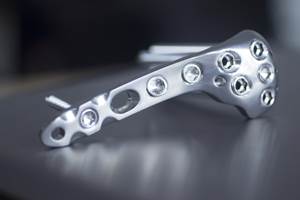Effective Deburring is Essential for Clean Parts
To achieve particulate cleanliness specifications, deburring is as essential as cleaning.
Being a female journalist, one of the most frequently asked questions I get when I tell people that I specialize in surface treatment and parts cleaning is, “Why of all things did you choose these fields?” “Because it is interesting” is my usual answer, which leads to an incredulous look. I then explain that parts cleaning has an impact on almost all products we use in daily life, such as cars, washing machines, mobile phones, and so on. However, seeing not just a small detail, but also the big picture makes topics all the more interesting.
This led me to thinking that parts cleanliness means much more than cleaning. Since requirements for process reliability in production and product quality are becoming more demanding, the number of companies that define particulate cleanliness specifications is constantly increasing. Depending on the part and its use, residual dirt values are more or less stringent, but every part has to be cleaned to the defined level. Additionally, the cleaning results often have to be controlled and documented. This frequently leads to investments in sophisticated cleaning machines and cleanliness control equipment or external technical cleanliness services.
Even though the cleaning equipment is optimally adapted to comply with the cleaning requirements of the parts, it happens every now and then that the particulate cleanliness specifications are not met: After verifying cleaning process (extraction) and filtration of the test liquid, the filter medium analysis shows that particulates that are too large have been removed from the part. Non-deburred or insufficiently deburred parts can be the reason for this failure because particulates can accumulate around the burrs or the burrs can come loose during the verifying cleaning procedure. To achieve particulate cleanliness specifications, deburring is as essential as cleaning.
Compared with other manufacturing processes such as stamping, where burrs occur because of one-dimensional cutting movements between the tool and the component, burr formation in machining processes is significantly more complex. The type of process used depends on various parameters such as the material properties, cutting tool quality, feed speed, cutting depth, part geometry, cutting edge radius, and the cutting and edge angles. Thus, deburring of machined parts often requires costly operations. For high precision components, the cost can add as much as 30 percent of the overall manufacturing cost.
In light of the costs of deburring, it pays to prevent burrs or at least reduce their occurrence. This effort is already underway during component design, with the elimination or reduction of tight radii and acute angles. Some approaches are also used during process planning. This involves, for example, the use of borers with large tip angles, allowing a reduction in the expected burr height at entrance and exit points.
Frequent tool changes help as well. Radius grinding is also recommended for burr reduction.
Burrs can be reduced on cross holes when tilt angles of more than 45 degrees in relation to the vertical are avoided. The processing sequence of large bores before small bores has a positive impact on burr formation. In milling, the formation of most burrs can be reduced or even avoided by optimizing the traverse paths. So it is a good idea to begin and end the process steps at less important edges and to avoid tool exits beyond the edge. If fast exits beyond the edge are avoided and feeding to the edges and at the outlet is reduced after long milling sequences, this also contributes to a reduction in burr formation, as does extensive cooling during milling.
When it comes to the selection of the best possible deburring process, the following factors play a role: the purpose of the component, the length of the burr before deburring and the maximum permissible residual burr, the batch size of the workpieces to be deburred, and the required deburring quality. The latter could also include whether a specified edge rounding, for cable lead-through, for example, is required, or whether a burr-free, sharp-edged surface must be achieved, as is frequently the case for hydraulic and pneumatic components.
Related Content
Kyzen Solvents Provide Ease of Cleaning for Medical Parts
The Metalnox line of solvent products are designed to improve reliability and increase the ease of cleaning in vacuum and vapor degreasing processes.
Read MoreCorrosion Prevention: How to Avoid the Enemy of Metal Parts
This chemical reaction that is a constant, indiscriminate and costly enemy of metal parts is preventable, but intentional measures must be taken and become an essential process within a company’s walls.
Read MoreSita’s CleanoSpector Measures Part Cleanliness
PMTS 2023: Handheld measuring device checks for cleanliness of parts to assure product quality as well as prior to follow-up processes.
Read MoreKyzen Solvents Provide Safe Parts Cleaning
The SLV901 and SLV803 solvents are formulated to maintain cleaning efficacy while providing a safe, environmentally friendly alternative to processes that use PFAS and HFCs.
Read MoreRead Next
5 Aspects of PMTS I Appreciate
The three-day edition of the 2025 Precision Machining Technology Show kicks off at the start of April. I’ll be there, and here are some reasons why.
Read MoreDo You Have Single Points of Failure?
Plans need to be in place before a catastrophic event occurs.
Read MoreSeeing Automated Workpiece Measurement in Real Time
User-friendly inspection software for CNC machining centers was shown at IMTS 2024 monitoring measurements between and after machining while performing SPC based on recorded measurement values.
Read More











.jpg;maxWidth=300;quality=90)










